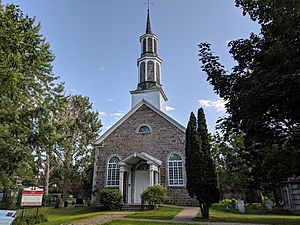St. Stephen's Anglican Church facts for kids
Quick facts for kids St. Stephen's Anglican Church |
|
|---|---|
| St. Stephen's with St. James Anglican Church of Chambly | |

St. Stephen's Anglican Church
|
|
| 45°26′52″N 73°16′26″W / 45.44784°N 73.27383°W | |
| Location | 2000 Bourgogne Street Chambly, Quebec, Canada J3L 1Z4 |
| Denomination | Anglican |
| Website | www.st-stephens-church-chambly.org |
| History | |
| Status | active |
| Founded | 1820 |
| Architecture | |
| Heritage designation | National Historic Sites of Canada |
| Designated | 1970 |
| Architect(s) | Edward Parkin |
| Architectural type | Palladian architecture |
| Groundbreaking | 1820 |
| Completed | 1820 |
| Specifications | |
| Length | 50 |
| Width | 30 |
| Height | 25 |
| Number of floors | 2 |
| Number of spires | 1 |
| Materials | Fieldstone |
| Administration | |
| Diocese | Montreal |
| Province | Canada |
St. Stephen's Anglican Church is a historic church located in Chambly, Quebec, Canada. It is part of the Anglican Church of Canada. This beautiful old building has a rich history, serving both soldiers and local families for many years.
Discover St. Stephen's Church
St. Stephen's Anglican Church is a special place in Chambly. It is known for its long history and beautiful design. The church is still active today, welcoming people for services and events.
A Church with History
The church was built way back in 1820. Its main purpose was to serve the soldiers stationed at Fort Chambly. It also welcomed the families who had moved to the area, including Loyalist settlers and other English-speaking residents.
For nearly 50 years, the church was a gathering place for both military personnel and civilians. This continued until the troops left Chambly in 1869. The church has stood strong for over 200 years, witnessing many changes in the community.
A National Historic Site
In February 1970, St. Stephen's Anglican Church received a very important title. It was named a National Historic Site of Canada. This means it is recognized as a place of great historical importance to the country.
The Historic and Monuments Board of Canada praised the church. They called it an excellent example of church architecture from the early 1800s in Canada. Its design, known as Palladian architecture, is quite special.
The church is located in a very historic area. It is close to the Fort Chambly National Historic Site of Canada. It is also near the Richelieu River and the Chambly Canal, which are important waterways.

